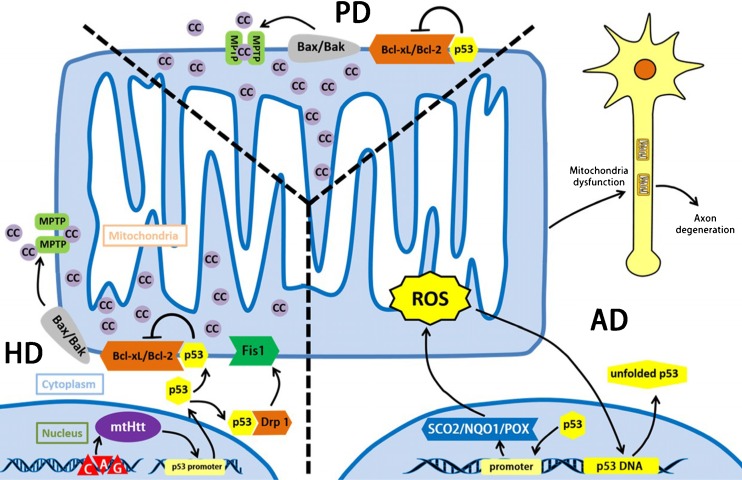Fig. 3.
p53 and mitochondria related etiology of three neurodegenerative diseases. Parkinson’s disease (PD) is now generally accepted that PD is associated with a selective loss of dopamine (DA) neurons, especially in the substantia nigra of the midbrain, p53 can bind to Bcl-2/Bcl-xL and release the Bax/Bak to form the MPTP, leading into the apoptosis finally.
Huntington’s disease (HD) is caused by the expansion of the coding CAG repeat in the open reading frame of the Huntingtin gene. The result of accumulation and expression of mutated Huntingtin protein (mtHtt) will lead to cellular dysfunctions, thus, causing HD. mtHtt binds to p53 and upregulates nuclear p53 level as well as p53 transcriptional activity. With the help of mtHtt, p53 binds to activated Drp1 under the stress state, which greatly enhance the interaction of Drp1 and Fis1 on mitochondrial outer membrane, causing the mitochondrial fission. Besides, the interaction of Bcl-xL/Bcl-2 with p53 contributes to the development of HD as well. Alzheimer’s disease (AD), acting the characteristics like the progressive decline of memory and cognitive functions as well as changes in behavior and personality. Its mechanism is still quite unclear, but more evidences indicate that ROS and the axon degeneration caused by mitochondrial dysfunction contribute greatly in the process of AD. p53 will transactivate SCO2, NQO1, POX. These factors will increase ROS generation under stress state. Besides, ROS break p53 DNA structure and DNA-binding domain, leading into the expression of unfolded p53, which can be marked as an early marker of oxidative imbalance in AD patients. Accumulation of ROS result in mitochondrial dysfunction, which functions vitally in the process of axon degeneration. Abbreviations: mtHtt: mutated Huntingtin protein, Drp1: dynamin-related protein 1, NQO1: quinone oxidoreductase or NAD(P)H dehydrogenase, quinone 1, POX: proline oxidase 1

